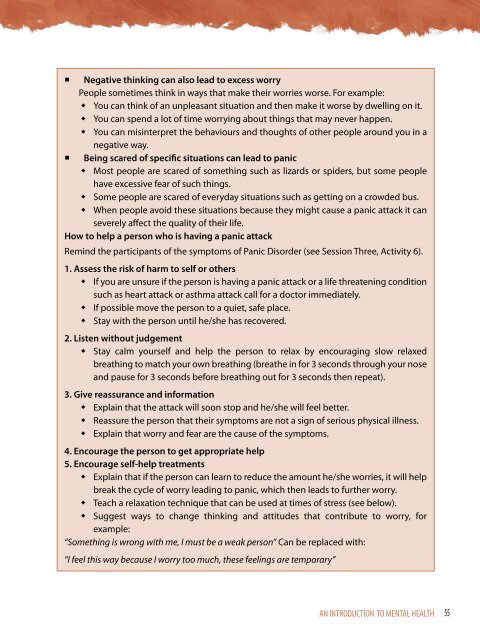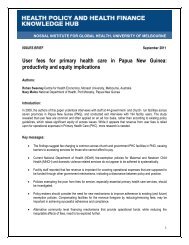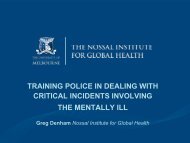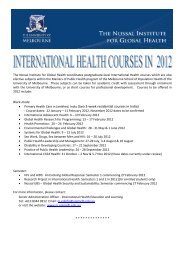AN INTRODUCTION TO MENTAL HEALTH - The Nossal Institute for ...
AN INTRODUCTION TO MENTAL HEALTH - The Nossal Institute for ...
AN INTRODUCTION TO MENTAL HEALTH - The Nossal Institute for ...
Create successful ePaper yourself
Turn your PDF publications into a flip-book with our unique Google optimized e-Paper software.
• Negative thinking can also lead to excess worry<br />
People sometimes think in ways that make their worries worse. For example:<br />
• You can think of an unpleasant situation and then make it worse by dwelling on it.<br />
• You can spend a lot of time worrying about things that may never happen.<br />
• You can misinterpret the behaviours and thoughts of other people around you in a<br />
negative way.<br />
• Being scared of specific situations can lead to panic<br />
• Most people are scared of something such as lizards or spiders, but some people<br />
have excessive fear of such things.<br />
• Some people are scared of everyday situations such as getting on a crowded bus.<br />
• When people avoid these situations because they might cause a panic attack it can<br />
severely affect the quality of their life.<br />
How to help a person who is having a panic attack<br />
Remind the participants of the symptoms of Panic Disorder (see Session Three, Activity 6).<br />
1. Assess the risk of harm to self or others<br />
• If you are unsure if the person is having a panic attack or a life threatening condition<br />
such as heart attack or asthma attack call <strong>for</strong> a doctor immediately.<br />
• If possible move the person to a quiet, safe place.<br />
• Stay with the person until he/she has recovered.<br />
2. Listen without judgement<br />
• Stay calm yourself and help the person to relax by encouraging slow relaxed<br />
breathing to match your own breathing (breathe in <strong>for</strong> 3 seconds through your nose<br />
and pause <strong>for</strong> 3 seconds be<strong>for</strong>e breathing out <strong>for</strong> 3 seconds then repeat).<br />
3. Give reassurance and in<strong>for</strong>mation<br />
• Explain that the attack will soon stop and he/she will feel better.<br />
• Reassure the person that their symptoms are not a sign of serious physical illness.<br />
• Explain that worry and fear are the cause of the symptoms.<br />
4. Encourage the person to get appropriate help<br />
5. Encourage self-help treatments<br />
• Explain that if the person can learn to reduce the amount he/she worries, it will help<br />
break the cycle of worry leading to panic, which then leads to further worry.<br />
• Teach a relaxation technique that can be used at times of stress (see below).<br />
• Suggest ways to change thinking and attitudes that contribute to worry, <strong>for</strong><br />
example:<br />
“Something is wrong with me, I must be a weak person” Can be replaced with:<br />
“I feel this way because I worry too much, these feelings are temporary”<br />
<strong>AN</strong> <strong>INTRODUCTION</strong> <strong>TO</strong> <strong>MENTAL</strong> <strong>HEALTH</strong> 55
















